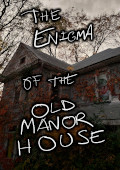The Enigma of the Old Manor House — 25 of 28
Daniel M. Stelzer
Volume IV - Miscellaneous
[This is where everything else got thrown as I did last-minute bug fixes before the deadline]
Some dust is a singular-named backdrop. It is in the kitchen, the huge room, the sunroom, the dining room, the library, the sitting room, the entrance, and the study. The description is "It's everywhere in here."
Some covered furniture is a lightbound singular-named backdrop. It is in the kitchen, the huge room, the sunroom, the dining room, the library, the sitting room, the entrance, and the study. The description is "Covered with sheets for who knows how long."
Some dim shapes are a darkbound backdrop. They are in the kitchen, the huge room, the sunroom, the dining room, the library, the sitting room, the entrance, and the study. The description is "They look horrifying in the darkness."
[Why can I not just use a region for this? I think it's a bug]
The description of yourself is "Dusty and a bit scraped up, but full of determination."
Singing is an action applying to nothing.
Understand "sing" or "shout" or "scream" or "panic" or "yell" as singing.
Instead of singing: say "You make some noise. It does nothing to make the house feel less vast and empty."
Understand the command "scooch" as "push".
Understand "hang [something preferably held] on/from [something]" as putting it on.
Specifically singing is an action applying to one topic. Understand "sing [text]" as specifically singing.
Before specifically singing: try singing instead.
Some moonlight is a backdrop. It is everywhere. The description is "A full moon is probably a good omen, right?" Understand "moon" or "light" as the moonlight.
[Rewritten tutorial that emphasizes the notebook and lantern]
To give the current tutorial:
if initial tutorial is true:
say "[tut]Type commands for your character to carry out in the game world. For example, you can LOOK to look around and get a description of your surroundings.[/tut]";
otherwise if we have not examined and there is another portable thing (called the item) in the location:
let T1 be "[the item]" in upper case;
let T2 be "[item]" in upper case;
say "[tut]Use the EXAMINE command to take a closer look at something. For example, EXAMINE [T1] (or just X [T2] for short).[/tut]";
otherwise if we have not examined:
say "[tut]Use the EXAMINE command to take a closer look at something. For example, EXAMINE ME (or just X ME for short).[/tut]";
otherwise if we have not taken and there is another portable thing (called the item) in the location:
let T be "[the item]" in upper case;
say "[tut]Many puzzles in interactive fiction involve manipulating the objects around you. Try to TAKE [T].[/tut]";
otherwise if there is an unhandled personal thing (called the item):
say "[tut][The item] looks important. Better take that too.[/tut]";
otherwise if we have not taken inventory and something is carried:
say "[tut]To see what you're currently carrying, type INVENTORY (or I for short).[/tut]";
otherwise if we have not examined the lantern:
say "[tut]The lantern seems important. Why not EXAMINE it for clues as well?[/tut]";
otherwise if we have not switched on the lantern:
say "[tut]From the description, it sounds like the lantern can be manipulated. Maybe we can turn it on and get some more light to see by.[/tut]";
otherwise if we have not examined the notebook:
say "[tut]The notebook seems important. Why not EXAMINE it for clues as well?[/tut]";
otherwise if we have not gone and there is a tut-viable direction (called the way):
let T be "[way]" in upper case;
say "[tut]You can navigate around the map with compass directions, like GO [T] (or just [T]).[/tut]";
otherwise:
say "[tut]You've got the hang of this now! If you get stuck, remember to EXAMINE anything that stands out, and see what you can do with those things: take and drop them, open and close them, push and pull them, climb them, put things inside them, and so on. If something goes horribly wrong, you can always UNDO and try something else.[/tut]";
now tutorial mode is false.
